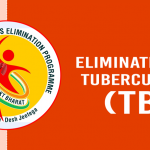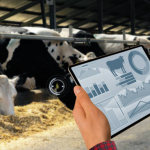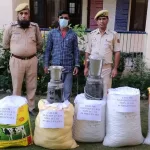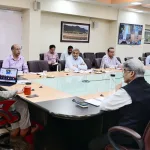Dairying being a way of life is considered as one of the major societal assets globally due to its economic and nutritional benefits.The Sector has been an integral part of the Indian economy for decadesand plays a pivotal role in achieving food security; improving rural economy and income; ending poverty and act as an essential means of livelihood to more than eight crore farmers.
Globally around 150 million households are engaged in dairy farming with an estimated production of approximately 965 million tonnes in 2023 (FAO’s Food Outlook, 2024). India has been the leading producer and consumer of dairy products worldwide since 1998 and presently ranked 1st, contributing to 25 per cent of global milk output. Milk production in the country has reached to 239.20 million tones, amounting approximately Rs.11.16 lakh crore during 2022-23 (As per National Accounts Statistics 2024) which is the highest of the agriculture produce and even more than the combined value of wheat and rice.
As per the conservative estimates, the annual milk production of Union Territory of Jammu & Kashmir is around 2600Th Tons of which Kupwara district contributes 162.17Th Tons with higher per capita milk availability, i.e., 520 gm per day, when compared to the national average. Currently the sector suffers from several constraints and faces significant challenges in terms of productivity, marketing, resource availability and organization. Milk distribution system, as has been observed is largely traditional, primitive, under-developed and exploitative with organized sector handling less than 5 per cent of marketable surplus milk ( i.e., approximately 702.63 Lakh Kgs) in the district.
As we cogitate on the ambitious journey of India’s dairy industry, we are being reminded of the ‘Operation Flood’, launched in early 70s under the visionary leadership of Dr Verghese Kurien, “Father of White Revolution”, the sector witnessed transformative journey from milk deficient nation to the world’s largest milk producer. It is noteworthy that much has been achieved through first White Revolution but the goals of sustainability and circularity are yet to be fully realized in the sector.
As the nation is all set to embark upon White Revolution 2.0, aiming to the realization of Hon’ble Prime Minister’s vision of ‘Sahkar se Samridhi’, this new-age initiative is expected to address the key challenges, particularly through women empowerment, enhancement of local milk production, strengtheningdairy infrastructure, expanding cooperative outreach, emphasizing sustainable circular bio-economy and boosting milk exports.
The dream of transforming India into a 5-trillion-dollar economy, to become third-largest economy globally and to establish our country as a fully developed Nation by 2047, the situation demands to explore and optimize every sector including dairying both at national as well as at the grass-root level.
The White Revolution 2.0 seeks to increase dairy cooperative milk procurement to 50% by expanding market access in underserved areas and increasing their share in the organized set-up. Under the ‘Margadarshika’ programme, it is being envisioned to establish panchayat/village-wise network of new computerized multipurpose primary agriculture cooperatives societies (MPACSs) with the funding of Rs. 40,000/- per society, for dairy related activities.
The plan is expected to tackle malnutrition by ensuring adequate nutrition to children and integrating existing (Dairy Processing and Infrastructure Development Fund-DIDF, Animal Husbandry Infrastructure Development Fund-AHIDF, National Programme for Dairy Development-NPDD) and upcoming schemes (new phase of NPDD 2.0 is being proposed). Under the scheme, the nationwide expansion of ‘Cooperation among Cooperative’ is also being launched under which dairy farmers are eligible to access interest free cash credit via RupayKisan Credit Cards and micro-ATMs to extend financial services to rural areas. In this new era of sustainability, key focus is also uponanimal welfare, circular bio-economy and climate financing.
District Kupwara is witnessing an unprecedented growth spell in the dairy landscape and is undergoing transformative leap-forward through focused government initiatives like Prestigious Holistic Agriculture Development Programme (HADP), Integrated Dairy Development Scheme (IDDS), Animal Husbandry Infrastructure Development Fund (AHIDF), Kisan Credit Card Scheme, Nationwide Artificial Insemination Progarame (NAIP), Accelerated Breed Improvement Programme (ABIP), Livestock Health and Disease Control Programme (LH&DCP) and many more.
In-fact Animal Husbandry Department Kupwara plays a vital role in shaping the dairy profile of the district, improving milk production (by way of establishment of high yielding dairy cow farms/ elite satellite heifer units), creating dairy processing and value addition infrastructure (establishment of bulk milk coolers vis-à-vis automatic milk collection units, milk value addition start-ups, etc), supporting farmers under waste to wealth management initiatives (establishing vermin composting units, dairy effluent treatment plants, biogas plant, cow dung drying/ log making units, etc), empowering farmers by way of promotion of FPOs/ SHGs/ etc, expanding cooperative coverage (more than 33 dairy cooperative societies are functional in the district), incentivizing dairy exports (subsidy on airway bill) and strengthening marketing support (subsidy on milk vans, refer vehicles, milk vending/ milk ATMs, etc).
Such initiatives not only result in ‘Doubling Farmer’s Income’ but also attract investment, create avenues for employment generation and entrepreneurship development. The facts speak volumes that the dairy enterprise in the district contributes roughly around Rs 768.56 crores annually to the UT economy.In recent times the selection of district Kupwara for ‘Prime Minister’s Award for Excellence’for its outstanding efforts in Holistic Development is a testimony that the district is on the right trackand the dairy sector is contributing towards sustainability and economic empowerment.
The White Revolution 2.0 in the district is emerging as a beacon of hope, modernity and circularity. This new era of sustainability in dairying is expected not only to revolutionize the sector in next few years by enhancing milk production, empowering women folks and lowering production costs through genetic improvement (importation of high genetic merit bulls), implementing advanced breeding technologies like embryo transfer (ET) and in-vitro fertilization (IVF) but also ensures sustainable growth while maintaining affordability and strengthening the rural economies.
These initiatives focus to enhance rural livelihoods, ensure a more inclusive and sustainable enterprise, strengthening entire milk value supply chainand potentially benefiting around forty thousand dairy farmers in the district. Dairying once considered a traditional occupation, is now attracting a new generation business minded entrepreneurs. With continued government support, it is expected that this reformative initiative shall empower farmers especially women folks, create additional job opportunities and foster a brighter sustainable future for the entire dairy landscape in the district.
(Author is Veterinary Surgeon Department of Animal Husbandry Kashmir. Feedback: [email protected])








